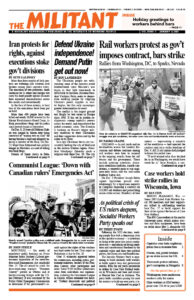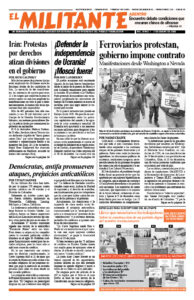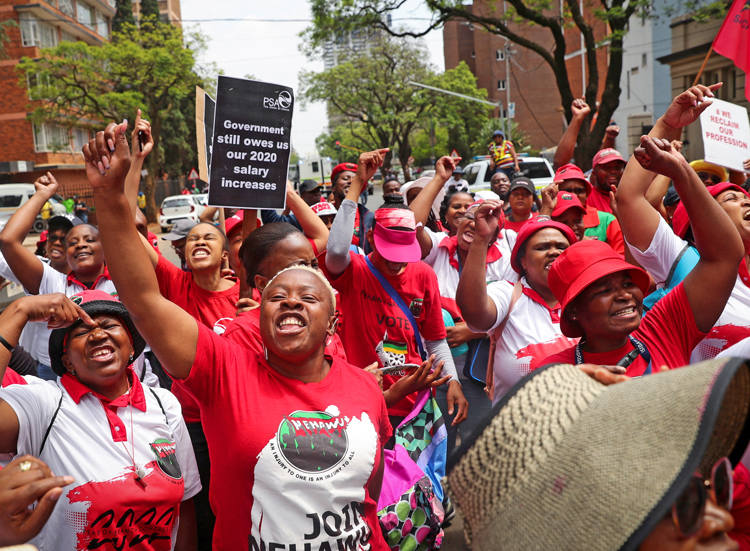With prices continuing to rise alongside growing numbers of layoffs, working people face the beginning of what could be an extended period of “stagflation” — a combination of increased prices and falling capitalist production, trade and jobs. The impact of today’s capitalist crisis is already having a devastating impact on workers and farmers.
Similar conditions face working people in the European Union and other imperialist countries, as well as China, Russia and across the semicolonial world. This has led to more protests, from France to Mongolia.
Grocery prices, rents, child care costs and other necessities keep going up, squeezing working people. The White House and the capitalist media claim a slight decline in the Consumer Price Index over the past few months — it was at 7.1% in November — shows that inflation is now “getting under control.”
But what working people face at the store paints a different picture. Grocery prices rose 12% from a year ago, with eggs up 49.1%, butter up 27% and bread 16.3%.
Rents were 7.9% higher than a year earlier, forcing increasing numbers of residents to move in with their families or friends.
While gasoline prices have declined from record highs over the past few months, independent truck drivers are still paying over $5 per gallon for diesel fuel, making it increasingly difficult to make ends meet. In addition, fuel oil, which is used to heat homes especially in New England, has risen 65.7% over the past year.
Bosses react to the capitalist crisis by attacking workers’ wages and schedules, pushing speedup, worsening working conditions and with layoffs. U.S. workers haven’t seen a rise in real wages since the 1970s, while inflation eats away at what our pay buys.
At the same time, increases in interest rates by the Federal Reserve this year, the steepest rise since the 1980s, have raised what workers owe on credit card debts, mortgages, rents and car loans. These conditions are rooted in U.S. and world capitalism’s deepening crises of production, trade and sharpening competition, exacerbated by the effects of the pandemic and Moscow’s invasion of Ukraine.
The employers claim the biggest danger is workers demanding higher pay. But it’s not workers’ wages that cause inflation — that’s a self-serving falsehood spread by the bosses and their politicians — but the workings of the capitalist system in crisis. Capitalist governments have been printing vast amounts of money — outstripping the output of commodities — to try to spur corporate borrowing and production and help their own country’s bosses compete with rivals. This leads to rising prices, and a disaster for working people. When they raised interest rates again Dec. 14, the Federal Reserve warned of more pain and growing unemployment to come.
The answer to soaring prices is for our unions to fight for cost-of-living escalator clauses in all union contracts, as well as for pensions, benefits and in government programs like Social Security that cover millions. We need to demand a shorter workweek with no cut in pay to spread the available work around and prevent layoffs. These are demands the union movement has fought for and won before and are essential to forging a fighting union movement today.
Economic downturn and inflation
U.S. bosses are laying off workers. In October job cuts jumped 13% to 33,843, the highest in 20 months.
In spite of the Christmas holiday season — normally the strongest sales period of the year, including on Black Friday after Thanksgiving — retail sales fell sharply in November. Giants like Walmart and Amazon are laying off. Amazon alone is cutting 10,000 jobs.
At the Stellantis Jeep Cherokee plant in Belvidere, Illinois, bosses told some 1,350 workers Dec. 9 that they’ll be without a job starting in February as the company prepares to produce electric vehicles instead.
At the same time, the number of workers the government counts as being part of the workforce continues to decline. The labor force participation rate declined for the third straight month in November, to 62.1%. About one in nine men aged 25 to 54 aren’t part of the labor force, compared to one in 50 in the mid-1950s.
The International Monetary Fund’s October World Economic Outlook report predicts, “The worst is yet to come and for many people, 2023 will feel like a recession.”
The unfolding economic crisis is combined with a deepening social crisis affecting working people. This is reflected in the decline in the birthrate to its lowest level since 1979; a drop in life expectancy to 76 years, also the lowest level since 1979; and a rise in suicides, particularly among young men. There’s also a record number of opiate overdoses, which is further boosted by the capitalist rulers’ profit-driven promotion of marijuana, and more.
Protests against rising prices and economic conditions have been taking place in every corner of the world. In mid-November tens of thousands of public sector workers in South Africa conducted a one-day nationwide strike for higher wages. Similar actions drew thousands more into the streets in Portugal, Albania, Mongolia and Hungary.


